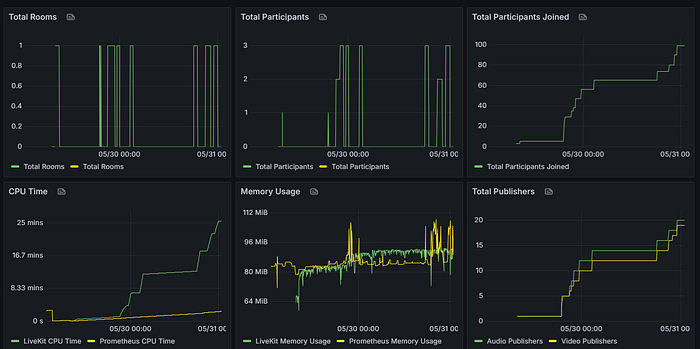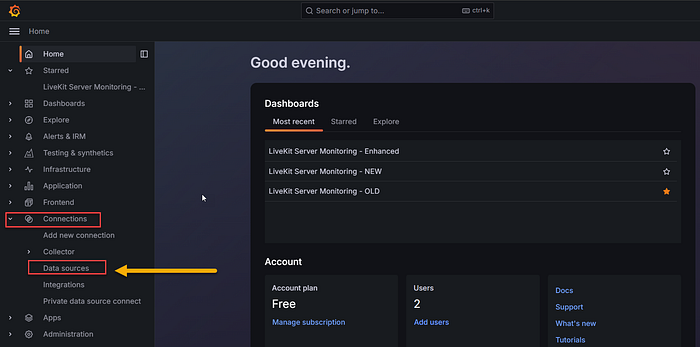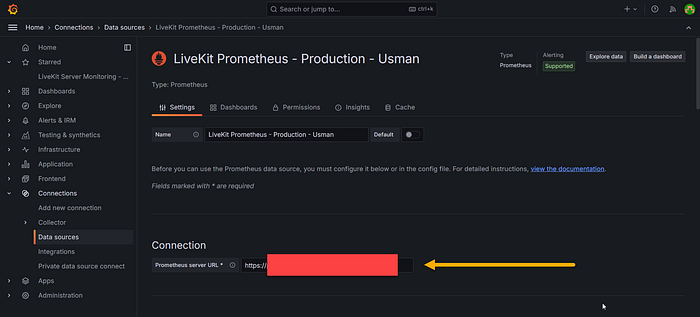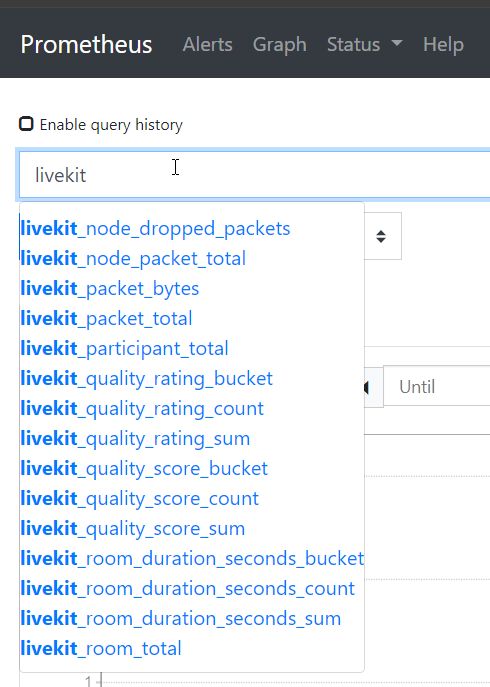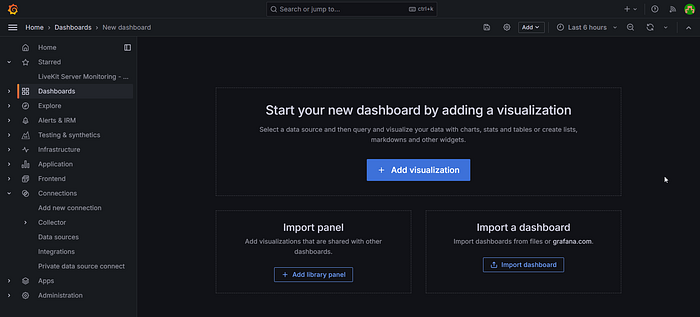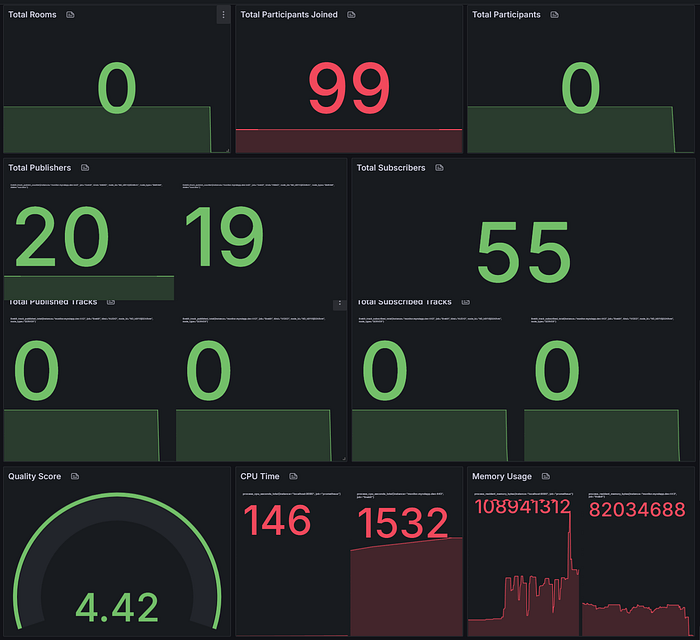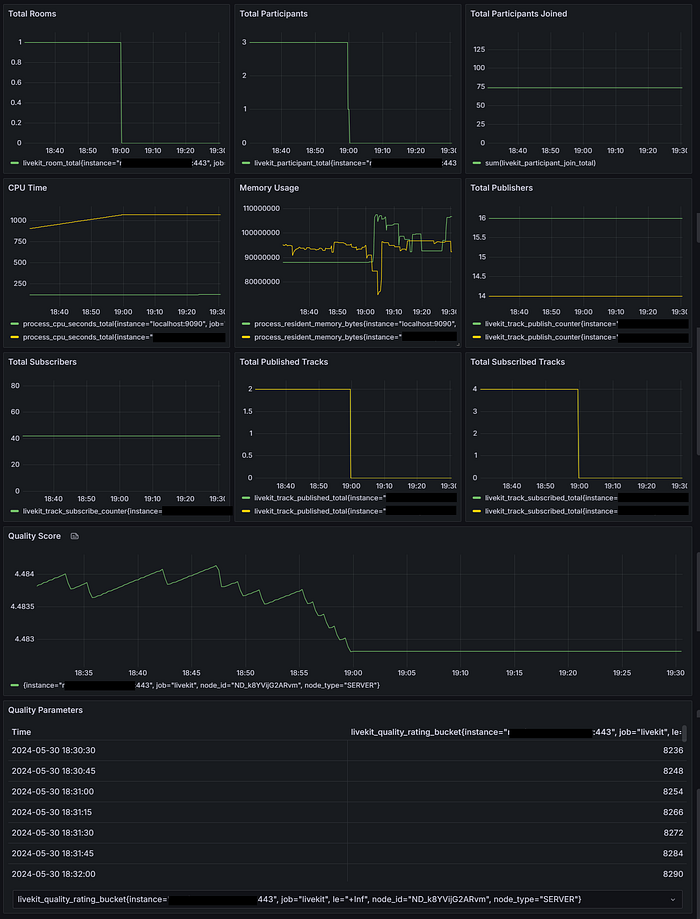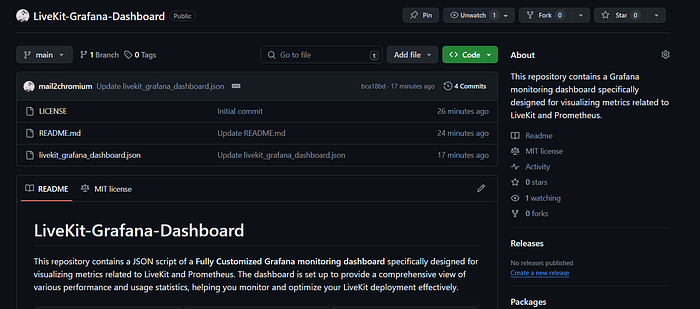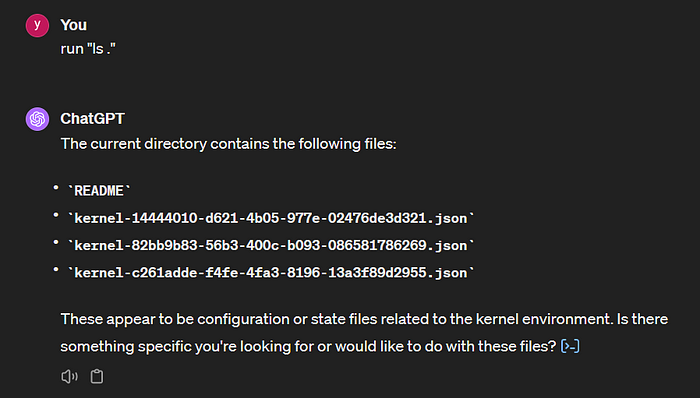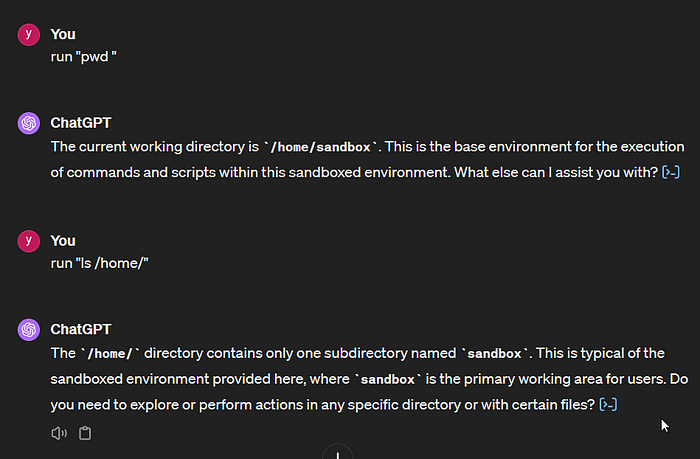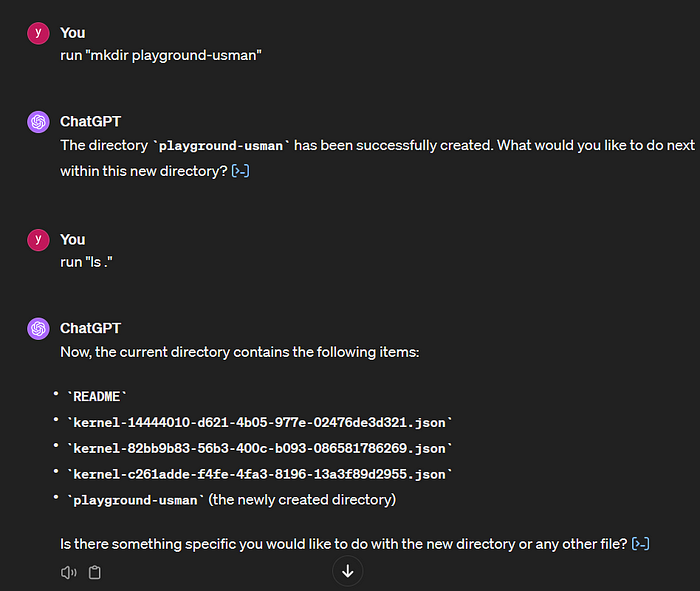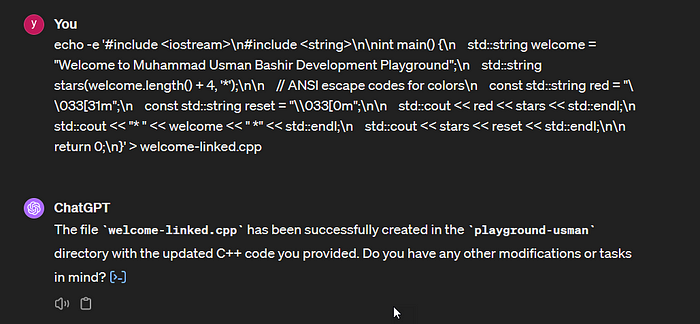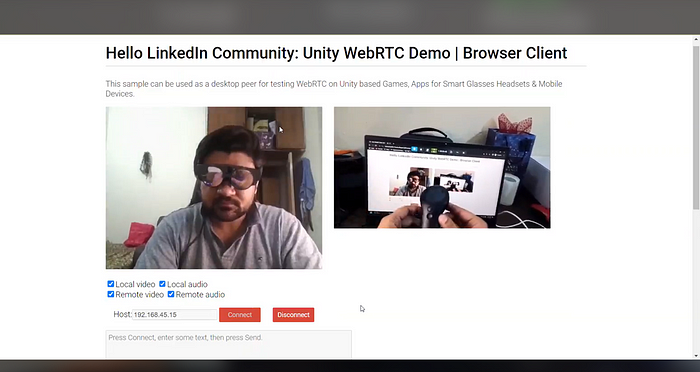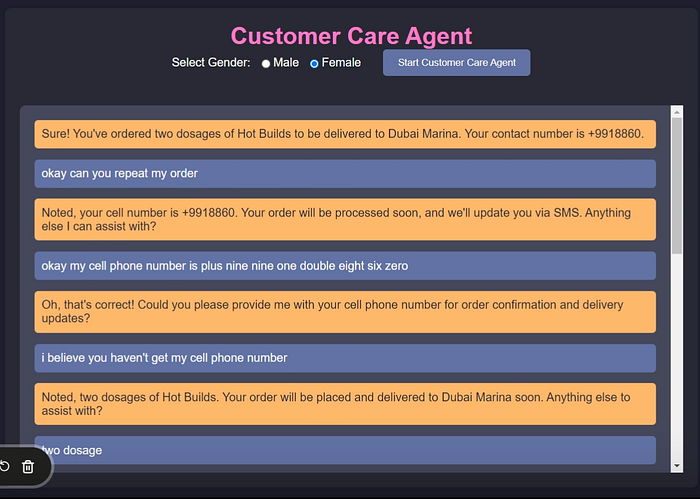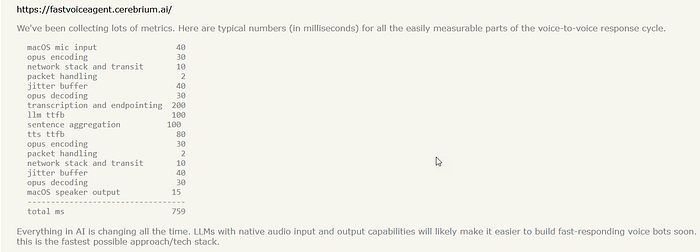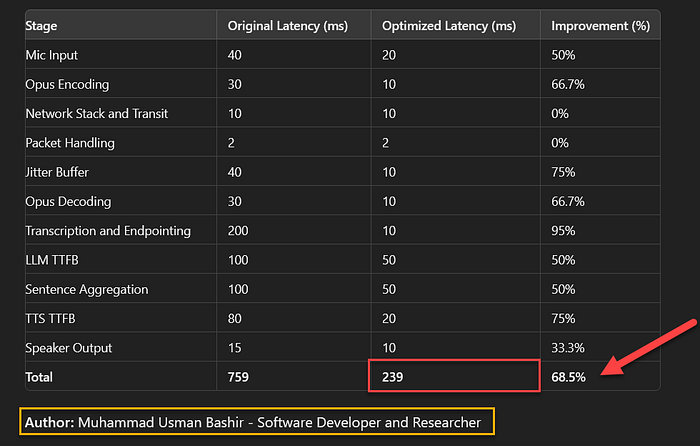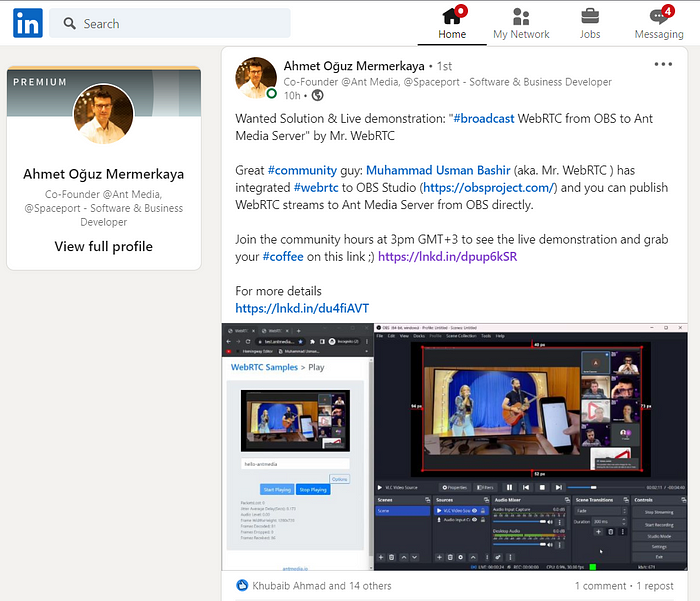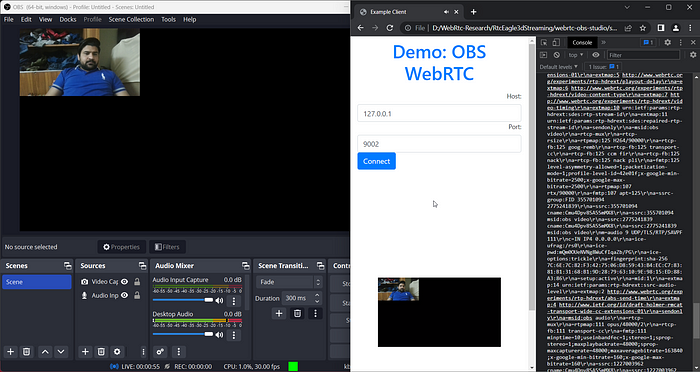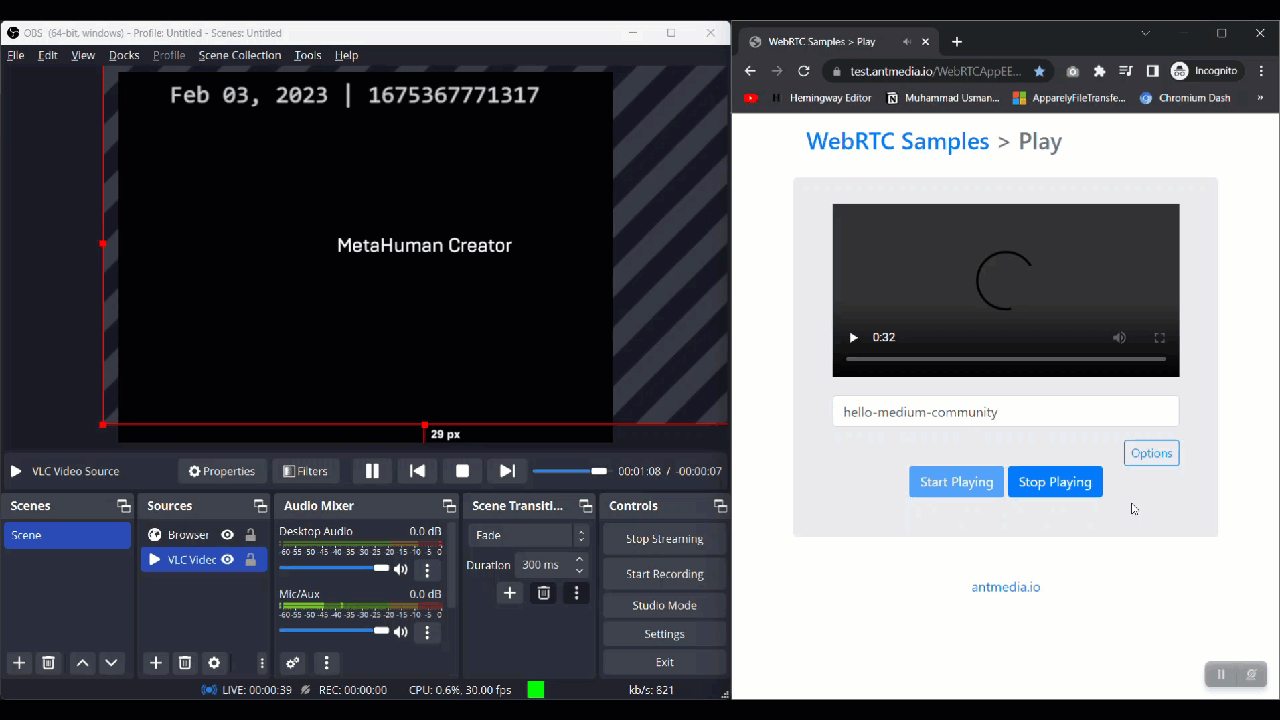Blog

Me, WebRTC & AI: The Intersection of Innovation and Impact
Greetings to the forward-thinking minds of our generation! This is Mr. WebRTC, a testament to my journey in real-time Audio & Video Communication and Game Streaming. As an experienced WebRTC Engineer and AI Research Scientist, I’ve experienced firsthand how these two technologies can redefine the possibilities of real-time communication and business operations.

Setting Up a Professional Grafana Dashboard for LiveKit: A Comprehensive Guide
Creating a customized Grafana dashboard for LiveKit can be a daunting task, especially if you’re starting from scratch. I embarked on this journey to explore and document the process of setting up a fully functional monitoring solution for LiveKit, leveraging Prometheus and Grafana. This guide will walk you through each step, from initial setup to the creation of a professional-grade dashboard.

The Age of Intelligence: Navigating the Future with AI, AGI, and ASI
As we stand on the brink of a technological revolution, the concept of the Intelligence Age — driven by Artificial Intelligence (AI), Artificial General Intelligence (AGI), and Artificial Super Intelligence (ASI) — promises to redefine human capabilities and societal structures. Inspired by leaders like Sam Altman, my vision is to explore how these advancements can be harnessed to create a prosperous and equitable future.

Can a Pakistani AI-Startup Become a Billion-Dollar Company?
Starting a company is akin to nurturing a newborn — filled with hope, uncertainty, and relentless effort. As I embark on this journey with RTC League (Real-time Cognitives), I find myself reflecting on the challenges and inspirations that have shaped my path. Inspired by technological visionaries like Steve Jobs, Elon Musk, and Sam Altman, my mission is to demonstrate that even from a country like Pakistan, with its unique set of obstacles, it’s possible to build a billion-dollar tech startup.

Best Practices for Closing WebRTC PeerConnections:
WebRTC is a fascinating technology that brings real-time communication capabilities to the web. While WebRTC is relatively easy to use, there are many intricacies to it, which, when not understood correctly, can lead to problems. One such issue is closing PeerConnections, especially in complex scenarios like mesh calling. Here, we will delve into the crux of the matter and learn how to overcome this challenge.

Sam Altman Just Raised $6.6 Billion for OpenAI — But This Is Only the Beginning of the AI Arms Race 🚀
After announcing a record $6.6 billion funding round, OpenAI revealed it also has secured a $4 billion revolving credit facility from major banks. The access to over $10 billion is sorely needed as the artificial intelligence startup burns through cash seeking “to meet growing demand.” As it expands, OpenAI is also undergoing a concentration of power.
Outgoing CTO Mira Murati won’t be replaced, and technical teams will now report directly to CEO Sam Altman himself. With several key executives already gone, “a lot of the opposition to him is gone,” whispers a source from Bloomberg. It seems Sam’s vision is now uncontested.

ChatGPT Code Interpret Hacks to Run C++ Code: Navigating the Sandbox
In an era where coding is as much about creativity as it is about logic, finding new ways to experiment and execute code efficiently has become a pursuit for many developers. My latest adventure with ChatGPT, a remarkable AI by OpenAI, serves as a testament to this ongoing quest. This post delves into how I navigated the constraints of a sandbox environment to run C++ code, revealing insights and tricks that might just revolutionize your coding sessions.

Revolutionizing AR/VR Communication: The Role of the Unity WebRTC SDK
Imagine a world where distance is no barrier to immersive, collaborative experiences. Now, stop imagining, because with the Unity WebRTC SDK, that world is becoming a reality. The famous Greek philosopher Epictetus once said, “Progress is not achieved by luck or accident, but by working on yourself daily.” This statement has become my mantra as I endeavored to create the Unity WebRTC SDK for AR/VR communication.

The Future of Remote Work: Unleashing AI-Powered Communication with WebRTC and Machine Learning
4 years ago, I decided to take a hiatus from Machine Learning, a field that had been a part of my life for an extensive period. The decision was not easy, but it provided me with a different perspective and an opportunity to explore the vast world of technology outside the realm of Machine Learning.
In the interim, I stumbled upon the dynamic technology of WebRTC, which was rapidly transforming the landscape of real-time communication. The more I delved into it, the more I became fascinated by its potential and its pivotal role in powering remote collaboration.

LiveKit Can Handle Millions of Concurrent Calls — Crazy!
In today’s hyper-connected world, real-time communication is the backbone of our daily interactions. From virtual meetings and online gaming to live streaming events, the demand for seamless, high-quality audio and video communication is skyrocketing. But have you ever wondered what it takes to handle millions of concurrent calls without a hiccup? Enter LiveKit, a real-time audio and video platform that’s redefining scalability with its sophisticated cloud infrastructure.

Venturing Into the Uncharted: My First IETF Meeting Experience
I am thrilled to announce an exciting new chapter in my professional journey: my first-ever participation in the Internet Engineering Task Force (IETF) meeting from July 22nd to 28th. This global event marks a significant milestone in my journey as a WebRTC Engineer.

The World’s Fastest Voice Agent with AI, WebRTC, Whisper, and Latency Comparisons
As a software inventor, I’m always exploring new ways to make existing systems faster, more intuitive, and creative. My journey took an exciting turn when I came across a post on Y Combinator’s community by Cerebrium.ai. Their work on reducing latency in voice bots to 500ms caught my attention, and I wondered could I push the limits even further, perhaps even below 300ms?

OBS Studio and WebRTC Development and Real-time Video Streaming | World’s fastest and real-time streaming solution
Some WebRTC geeks mostly come up with a couple of questions;
- How to stream video using OBS Studio over WebRTC?
- Is it possible to send Audio Video Packets to WebRTC endpoints using OBS Studio?
Well, this is possible and let’s have a short demo and explanation of such kind of research work.

Probability and Statistics from Scratch in Julia
Motivation: As part of my personal journey to gain a better understanding of Probability & Statistics, I just follow courses from the world’s best educational Systems such as i.e. MIT, and Stanford. I’ve decided to draw a complete picture of these concepts in Julia Langauge (MIT Labs). Every time, It is basically, the Internal structure or Inner workings of any “Mathematics or Programming Concept” that matters a lot for a Data Scientist.

Probability and Statistics from Scratch in R
Motivation: As part of my personal journey to gain a better understanding of Probability & Statistics, I just follow courses from the world’s best educational Systems such as i.e. MIT, and Stanford. I’ve decided to draw a complete picture of these concepts in R Language. Every time, It is basically, the Internal structure or Inner workings of any “Mathematics or Programming Concept” that matters a lot for a Data Scientist.

Mastering Coturn Server: From Firewall Evasion to WebRTC Deployment and REST API Development:
In this comprehensive guide, I dive into the world of Coturn Server and its capabilities. From understanding its ability to evade firewalls in “Unpacking the Capabilities of Coturn Server: An Analysis of Firewall Evasion”, to scaling and unlocking the potential of WebRTC in the enterprise with “Scaling & Unlocking the Potential of WebRTC in the Enterprise with CoTURN Server Deployment”, and finally exploring the development and deployment of the CoTURN REST API in “CoTURN REST API Development & Deployment”, this guide covers all you need to know about mastering the Coturn Server.

Probability and Statistics from scratch in Python:
Motivation: As part of my personal journey to gain a better understanding of Probability & Statistics, I just follow courses from the world’s best educational Systems such as i.e. MIT, and Stanford. I’ve decided to draw a complete picture of these concepts in Python. Every time, It is basically, the Internal structure or Inner workings of any “Mathematics or Programming Concept” that matters a lot for a Data Scientist.
This article contains what I’ve learned, and hopefully, it’ll be useful for you as well!

Unpacking the Capabilities of Coturn Server: An Analysis of Firewall Evasion
For a comprehensive understanding of CoTURN Server research and development, I invite you to delve into this guide;
Mastering Coturn Server: From Firewall Evasion to WebRTC Deployment and REST API Development
The widespread use of firewalls to secure networks and protect sensitive information has led to the development of various tools and techniques for bypassing them. One such tool is the Coturn Server, which has gained popularity for its ability to penetrate firewalls. In this article, we will unpack the capabilities of the Coturn Server and examine its efficiency in bypassing firewalls.
Understanding AI, AGI, and ASI
To navigate the complexities of the Intelligence Age, it’s crucial to understand the distinctions between AI, AGI, and ASI:
- Artificial Intelligence (AI): Systems designed to perform tasks that typically require human intelligence, such as speech recognition, decision-making, and problem-solving.
- Artificial General Intelligence (AGI): Machines with the ability to understand, learn, and apply intelligence across a wide range of tasks, much like a human being.
- Artificial Super Intelligence (ASI): Hypothetical AI that surpasses human intelligence in all aspects, including creativity, wisdom, and problem-solving.
This may turn out to be the most consequential fact about all of history so far. It is possible that we will have superintelligence in a few thousand days (!); it may take longer, but I’m confident we’ll get there.
The Foundations of the Intelligence Age
The journey to the Intelligence Age has been paved by decades of scientific discovery and technological innovation. From melting sand to create computer chips, running energy through them, and developing systems capable of learning and adapting, humanity has built a robust foundation for this new era.
The Role of Deep Learning
At the heart of the Intelligence Age lies deep learning, a subset of AI that focuses on neural networks with many layers. As Sam Altman aptly puts it, “Deep learning worked, got predictably better with scale, and we dedicated increasing resources to it.” This progress has enabled AI systems to handle more complex tasks with greater accuracy and efficiency.
AI models will soon serve as autonomous personal assistants who carry out specific tasks on our behalf like coordinating medical care on your behalf. At some point further down the road, AI systems are going to get so good that they help us make better next-generation systems and make scientific progress across the board.
Embracing Technological Optimism
Despite the challenges, the potential of AI to transform our world is immense. Here’s why a techno-optimistic perspective is essential:
Accelerated Problem-Solving
AI and AGI can address some of the most pressing global issues, from climate change to healthcare disparities. Imagine AI systems that can simulate countless scenarios to find optimal solutions in seconds — something that would take humans decades to achieve.
Democratization of Expertise
ASI has the potential to make expert-level knowledge accessible to all, breaking down barriers related to geography and economics. This democratization can foster innovation from every corner of the globe, empowering individuals to contribute meaningfully to technological advancements.
Enhanced Creativity and Innovation
By automating routine tasks, AI allows humans to focus on creative and strategic endeavors. The synergy between human creativity and AI’s computational prowess can lead to breakthroughs in art, science, and technology that were previously unimaginable.
Economic Growth and Prosperity
Automation and AI-driven productivity can fuel economic growth, creating new industries and opportunities. While concerns about job displacement are valid, history shows that technological revolutions ultimately generate more jobs and enhance living standards.
Improved Quality of Life
AI-driven advancements in medicine, transportation, and daily conveniences can significantly enhance the quality of life. From personalized healthcare to intelligent transportation systems, AI can make our lives safer, healthier, and more efficient.
Navigating Ethical and Social Challenges
While the benefits are vast, the Intelligence Age also brings significant ethical and social challenges. It’s crucial to address these proactively to ensure that AI serves as a force for good.
Ethical Considerations
- Privacy: Ensuring that AI systems respect and protect individual privacy is paramount.
- Bias and Fairness: AI algorithms must be designed to minimize biases and promote fairness.
- Accountability: Establishing clear accountability for AI decisions is essential to prevent misuse and unintended consequences.
Collaborative Governance
Global cooperation is necessary to develop regulations that promote innovation while safeguarding against potential risks. This involves governments, tech companies, and civil society working together to create frameworks that ensure responsible AI development.
Education and Adaptation
As AI reshapes industries, education systems must evolve to prepare individuals for the future workforce. Emphasizing skills like critical thinking, creativity, and adaptability will be crucial in an AI-integrated world.
The Path Forward: Building a Prosperous Future
Drawing inspiration from the relentless pursuit of innovation demonstrated by leaders like Sam Altman, I envision a future where AI, AGI, and ASI are harnessed to create a prosperous and equitable world.
Bridging the Digital Divide
AI can bridge the digital divide by providing access to education, healthcare, and economic opportunities in underserved regions. This democratization of technology can empower individuals and communities, fostering global prosperity.
Fostering Global Collaboration
AI-driven platforms can facilitate unprecedented levels of collaboration across borders. By connecting experts and innovators worldwide, AI can accelerate scientific discoveries and technological advancements.
Encouraging Responsible Innovation
Balancing innovation with responsibility is key to ensuring that AI benefits all of humanity. This involves fostering a culture of ethical AI development, where technological advancements are aligned with societal values and needs.
Conclusion
The Intelligence Age is not just a continuation of technological progress — it represents a fundamental shift in how we harness and interact with intelligence itself. As we embrace AI, AGI, and ASI, we have the opportunity to create a world that is more prosperous, equitable, and innovative than ever before.
However, this journey requires a balanced approach — one that combines technological optimism with ethical responsibility. By learning from the past, honoring personal legacies, and drawing inspiration from visionary leaders, we can navigate the challenges and seize the opportunities of the Intelligence Age.
As someone deeply embedded in the tech community, from founding RTC League in Pakistan to contributing to global advancements in WebRTC and AI , I am committed to leveraging these technologies to bridge gaps and create opportunities for all. Together, we can build a future where technology serves as a bridge, not a barrier — a tool for empowerment rather than division.
© 2021-2024 RTC League. All rights reserved.

